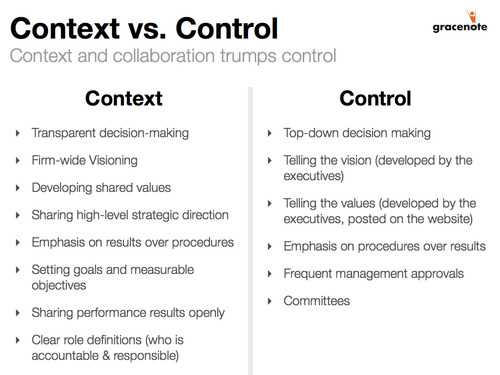“Unity is strength…when there is teamwork and collaboration, wonderful things can be achieved.”
~ Mattie Stepanek
When leaders work with high-performing individuals on a team, controlling people, that is, telling people what to do and how to do it, is rarely effective. As Dan Pink so eloquently describes in his book, Drive, most of us crave autonomy, mastery, and purpose. The secret to great results and happiness—at work, at school and at home—is the deep human need to direct our own lives, to learn and create new things, and make the world better through our contributions.
One of the challenges that almost everyone faces as a new manager is the impulse to control and direct. It can be difficult to delegate tasks to those with less experience—to empower people who are learning things the manager may have mastered long ago. As we drive for results, it’s not easy for most people to let go and relinquish control.
To be sure, there are times when control is justified and necessary. In times of crisis, for example, leaders must often be more directive. When working with people in roles for which they’re unprepared, managers must sometimes exert more control and provide greater guidance. However, these situations should be temporary and the exception rather than the norm.
So, if control is not the answer to effective leadership, what is? For the best outcomes, leaders should focus on three aspects:
- inspiring others;
- encouraging collaboration; and
- setting context.
A great example of this is the approach an organization takes to establishing vision and strategy. In an environment of command and control, executives declare a vision and strategy without input from the team. However, the visioning process, the broader conversation across the team, is often more valuable than the vision statement itself. People are more inspired and more connected, both to the vision and to one another, when they have contributed to its development in meaningful ways. We need agile, flexible models that allow good ideas to come from anywhere. We need strategies that are understood and embraced by the many rather than the few.
The table below lists some aspects of context-setting and some aspects of control.

Some questions for us to consider:
- Does your organization have a culture of freedom and responsibility or of command and control?
- Do the best leaders you’ve encountered bring a mindset of WE or a mindset of ME?
- If purpose is a better motivator than money, how do you get people to truly buy into the purpose of your organization?
- Is your strategic direction understood and embraced by the many or only a few at the top?
- What happens in the absence of both context and control?
- Have you developed enough trust within your team to share performance results openly?
- Do you encourage failure and learning as a positive or do you punish failure as a negative?
- Do you have mechanisms in place that allow good ideas to arise from anywhere within your organization?
.



